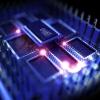ERC Stories - How to entangle two electrons – and do it again and again
"Electrons are in a strange state in superconducting materials," starts Dr Csonka. "Our goal is to use these superconductors to generate entangled, spatially separated electron pairs that behave as a single quantum object." Inside the atom, electrons exist in orbits around the central nucleus. And just as the Earth spins daily on its axis while orbiting the sun, electrons also have spin. That is where the similarity ends however. Electron spin is a quantum concept that is almost impossible to visualise but, since spin information is preserved when electrons are transmitted, this quantum spin could provide a basis for quantum computers and information processing. Particles such as electrons can also become 'entangled', so that any measurement of the spin of one of them is correlated with the spin measured on the other – no matter how far apart they are! The 'non-locality' of this entanglement means two particles can be considered as a single object, even though they may be separated by some distance – a strange idea that scientists are keen to study in ever-more detail. splitting pairs one specific example of this is called a 'Cooper pair', naturally formed by two electrons in a superconductor – a material with zero, or nearly zero, electrical resistance. "Our objective is to split the electrons of a Cooper pair and get one electron to one lead or electrode and the other member of the pair to the other lead," says Dr Csonka. To do this he uses a 'Single-electron transistor' (SET) at each end of a superconductor to 'trap' the entangled electrons. "This acts like a turnstile where people can only enter one by one," he explains. The SET allows only one electron to be added at a time, leaving the second electron of the pair free in the superconductor. "But superconductors don’t like single electrons," continues Dr Csonka, "so the free electron moves immediately to the other end, where it enters another SET, so we have one member of the entangled pair at each end." With leads attached to the SETs, the apparatus becomes an 'entangler device' that can produce and control entangled pairs efficiently. "Before we started, the efficiency for such devices was around 3 %," says Dr Csonka, "but we have already achieved 20 % efficiency and are now working to optimise the transistors and increase the efficiency further." still entangled? the second part of the project aims to prove that the separated pair of electrons does not lose their entanglement – and to see how far, and for how long, they can be separated while remaining entangled. "If we can optimise the splitting, then entangled pairs can be used in quantum computers" explains Dr Csonka, "where entangled quantum bits will need to be positioned relatively far from each other." "Furthermore, we can combine our entangled electron pair generator with an 'electron/photon converter'," he continues. "The spin information of the electron is then translated to the polarisation of the photon – and since the electrons are entangled, so are the photons." Thus a fast, efficient entangled electron generator can also become an efficient generator of entangled photons. By 'mass producing' entangled pairs of electrons and photons, Dr Csonka hopes to provide the raw materials for much further experimentation – and bring practical quantum computers one step closer to reality. project details: - Principal investigator: Dr Szabolcs Csonk - Host institution: Budapest University of Technology and Economics, Hungary - Project: Cooper pairs as a source of entanglement (Coopairent) - ERC call: Starting Grant 2011 - ERC funding: EUR 1.5 million - Project duration: five years further information - Website of Dr Szabolcs Csonka’s Research Group(opens in new window) glossary - Copenhagen interpretation – a widely-accepted view of quantum mechanics that deals only with probabilities of observing and measuring properties of 'particles', which also behave as waves. - Electron spin, or 'quantum spin' – just as the Earth spins daily on its axis, even as it makes its yearly orbit around the sun, so electrons have their own 'spin' whilst also orbiting the nucleus of an atom. There the similarities end, however, as this 'quantum spin' does not correspond to a rotation in ordinary physical space. - Quantum entanglement – is the result of two particles (e.g. photons or electrons) interacting in such a way that the pair (the position, momentum, spin, polarisation, etc. of both particles) is described by a single inseparable quantum mechanical description. According to the Copenhagen interpretation, the observable values of their shared state are undetermined until measured, at which time one member of the pair takes on a definite value (e.g. spin up) and the other member will be found to have taken a correlated value (e.g. spin down). The results of measurements performed on each individual member of the pair are correlated, irrespectively of what distance separates the entangled particles.



